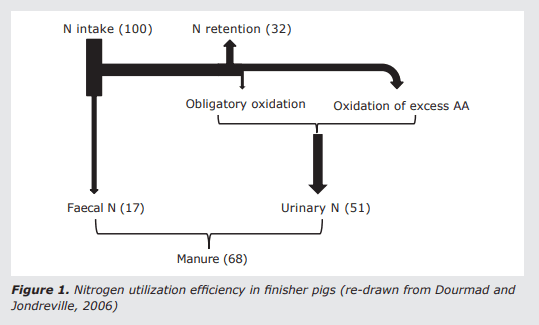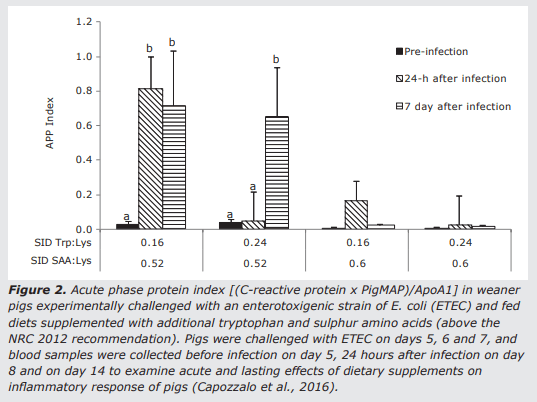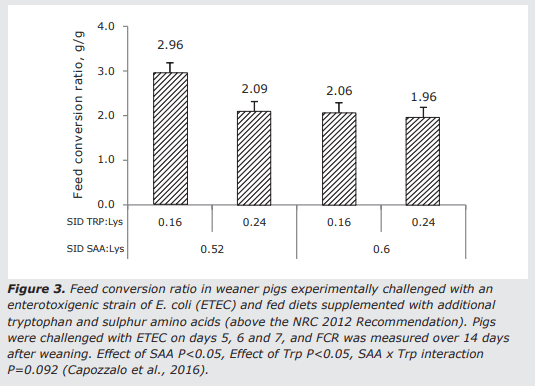Improving protein utilization efficiency through better understanding of immune and stress responses in pigs
Efficient utilization of dietary protein is affected by many factors including the animal’s physiological requirements for amino acids, genetic potential for protein deposition, digestion/absorption of dietary amino acids, use of antibiotics, and metabolism/partitioning of absorbed amino acids. Although other factors are equally important for protein utilization efficiency, this presentation will highlight the roles of immune and stress responses of pigs on protein utilization efficiency as pigs in commercial production system are exposed to considerable environmental stressors that alter the way pigs partition the absorbed nutrients. Emphasis will be given to the currently available nutritional strategies to achieve more efficient protein utilization under such environmental stress.



Campbell R.G. and Dunkin A.C. (1983) The effects of energy intake and dietary protein on nitrogen retention, growth performance, body composition and some aspects of energy metabolism of baby pigs. British Journal of Nutrition, 49, 221-230.
Carr J.R., Boorman K.N. and Cole D.J.A. (1977) Nitrogen retention in the pig. British Journal of Nutrition, 37, 143-155.
Capozzalo M.M. (2015) Determination of the standardized ileal digestible requirements of tryptophan and sulphur amino acids in weaner pigs under conditions of enterotoxigenic Escherichia Coli challenge. Ph.D dissertation, Murdoch University, Murdoch.
Capozzalo M.M., Kim J.C., Htoo J., De Lange C.F.M., Hansen C.F., Resink J. and Pluske J.R. (2016) Pigs experimentally infected with an enterotoxigenic strain of Escherichia coli have improved feed efficiency and indicators of inflammation with dietary supplementation of tryptophan and methionine in the immediate postweaning period. Animal Production Science (accepted for publication).
Cera K.R., Mahan D.C. and Reinhart G.A. (1988) Effects of dietary dried whey and corn oil on weanling pig performance, fat digestibility and nitrogen utilization. Journal of Animal Science, 66, 1438-1445.
Charmandari E., Tsigos C. and Chrousos G. (2005) Endocrinology of the stress response. Annual Review of Physiology, 67, 259-284.
De Ridder K., Levesque C.L., Htoo J.K. and De Lange C.F.M. (2012) Immune system stimulation reduces efficiency of tryptophan utilization for body protein deposition in growing pigs. Journal of Animal Science, 90, 3485-3491.
Dourmad J.-Y. and Jondreville C. (2006) Nutritional approaches to reduce nitrogen, phosphorus and trace elements in pig manure. Livestock production and society, 135-150. In: Geers R. and Madec F. (editors), Wageningen Academic Publishers, Netherlands.
Drew M.D., Schafer T.C. and Zijlstra R.T. (2012) Glycemic index of starch affects nitrogen retention in growing pigs. Journal of Animal Science, 90, 1233-1241.
Fabian J., Chiba L.I., Frobish L.T., McElhenney W.H., Kuhlers D.L. and Nadarajah K. (2004) Compensatory growth and nitrogen balance in grower-finisher pigs. Journal of Animal Science, 82, 2579-2587.
Genesan S., Reynolds C., Hollinger K., Pearce S.C., Gabler N.K., Baumgard L.H., Rhoads R.P. and Selsby J.T. (2016) Twelve hours of heat stress induces inflammatory signaling in porcine skeletal muscle. American Journal of PhysiologyRegulatory, Integrative and Comparative Physiology. In Press, DOI: 10.1152/ ajpregu.00494.2015. Iseri V.J. and Klasing K.C. (2013) Dynamics of the systemic components of the chicken (Gallus gallus domesticus) immune system following activation by Escherichia coli; implications for the costs of immunity. Developmental and Comparative Immunology, 40, 248-257.
Kim J.C., Mullan B.P., Frey B., Payne H.G. and Pluske J.R. (2012a) Whole body protein deposition and plasma amino acid profiles in growing and/or finishing pigs fed increasing levels of sulfur amino acids with and without Escherichia coli lipopolysaccharide challenge. Journal of Animal Science, 90, 362-365.
Kim J.C., Hansen C.F., Mullan B.P. and Pluske J.R. (2012b) Nutrition and pathology of weaner pigs: Nutritional strategies to support barrier function in the gastrointestinal tract. Animal Feed Science and Technology, 173, 3-16.
Kim J.C., Mullan B.P. and Pluske J.R. (2013) Impact of the systemic response to stressors and subclinical and clinical infection on intestinal barrier function and growth in pigs. Manipulating Pig Production XIV, 62-76. In: Pluske, J.R. and Pluske, J.M. (editors), Australasian Pig Science Association, Werribee, Australia.
Kim J.C., Mullan B.P. and Pluske J.R. (2014) Effects of increasing the dietary level of vitamin E, without and with a low inclusion level of aspirin, on systemic responses of weaned pigs challenged with haemolytic E. coli. Journal of Animal Science, 92 (E-Suppl. 2), 85, Abstract 191.
Klasing K.C. (2004) The cost of immunity. Acta Zoologica Sinica, 50, 961-969.
Koopmans S.J., Guzik A.C., Van der Meulen J., Dekker R., Koqut J. and Southern L.L. (2006) Effects of supplemental L-tryptophan on serotonin, cortisol, intestinal integrity, and behavior in weanling piglets. Journal of Animal Science, 84, 963-971.
Koopmans S.J., Ruis M., Dekker R. Van Diepen H., Koqut J. and Morz Z. (2005) Surplus dietary tryptophan reduces plasma cortisol and noradrenaline concentrations and enhances recovery after social stress in pigs. Physiology & Behavior, 85, 469-478.
Le Floc’h N., Melchior D. and Seve B. (2004) The importance of dietary tryptophan for preserving growth and controlling inflammatory response of weaned pigs submitted to immune stress. Animal Production in Europe: The Way Forward in a Changing World, Proceedings of the InBetween Congress of the ISAH, Vol I, 239- 240, Madec, F. and Clement, G. (editors), St Malo, France.
Le Floc’h N. and Seve B. (2007) Biological roles of tryptophan and its metabolism: Potential implications for pig feeding. Livestock Science, 112, 23-32.
Le Naou T., Le Floc’h N., Louveau I., Van Milgen J. and Gondret F. (2014) Meal frequency changes the basal and time-course profiles of plasma nutrient concentrations and affects feed efficiency in young growing pigs. Journal of Animal Science, 92, 2008- 2016.
Libao-Mercado A.J., Leeson S., Langer S., Marty B.J. and De Lange C.F.M. (2006) Efficiency of utilizing ileal digestible lysine and threonine for whole body protein deposition in growing pigs is reduced when dietary casein is replaced by wheat shorts. Journal of Animal Science, 84, 1362-1374.
Markus C.R. (2008) Dietary amino acids and brain serotonin function; implications for stress-related affective changes. Neuromolecular Medicine, 2008, 247-258.
McLamb B., Gibson A.J., Overman E.L., Stahl C. and Moeser A.J. (2013) Early weaning stress in pigs impairs innate mucosal immune responses to enterotoxigenic E. coli challenge and exacerbates intestinal injury and clinical disease. PLoS On, 8, e59838.
Mereu A., Tedo G., Moeser A.J., Rimbach G. and Ipharraguerre I.R. (2015) Cromolyn-mediated improvement of intestinal barrier function is associated with enhanced piglet performance after weaning. BMC Veterinary Research, 11, 275.
Miller D.S. and Payne P.R. (1964) Dietary factors influencing nitrogen balance. Proceedings of the Nutrition Society, 23, 11- 18.
Moeser A.J., Klok C.V., Ryan K.A., Wooten J.G., Little D., Cook V.L. and Blikslager A.T. (2007) Stress signaling pathways activated by weaning mediated intestinal dysfunction in the pig. American Journal of Gastrointestinal & Liver Physiology, 292, G173-G181.
Montilla S.I.R., Johnson T.P., Pearce S.C., Gardan-Salmon D., Gabler N.K., Ross J.W., Rhoads R.P., Baumgard L.H., Lonergan S.M. and Selsby J.T. (2014) Heat stress causes oxidative stress but not inflammatory signaling in porcine skeletal muscle. Temperature, 1, 42-50.
Mowart A.M. (2003) Anatomical basis of tolerance and immunity to intestinal antigens. Nature Reviews Immunology, 3, 331-341. National Research Council (2012) Nutrient requirement of swine, National Academy Press, Washington DC, USA.
Overman E.L., Rivier J.E. and Moeser A.J. (2012) CRF induced intestinal epithelial barrier injury via the release of mast cell proteases and TNF-α. PLoS One, 7, e39935.
Otto E.R., Yokoyama M., Ku P.K., Ames N.K. and Trottier N.L. (2003) Nitrogen balance and ileal amino acid digestibility in growing pigs fed diets reduced in protein concentration. Journal of Animal Science, 81, 1743-1753.
Paradis M.A., Gebhart C.J., Toole D., Vessiem G., Winkelman N.L., Bauer S.A., Wilson J.B. and McClure C.A. (2012) Subclinical ileitis: Diagnostic and performance parameters in a multi-dose mucosal homogenate challenge model. Journal of Swine Health and Production, 20, 137-141.
Pastorelli H., Le Floc’h N., Merlot E., Meunier-Salaun M.C., Van Milgen J. and Montagne L. (2012a) Sanitary housing conditions modify the performance and behavioral response of weaned pigs to feedand housing-related stressors. Animal, 6, 1811-1820.
Pastorelli H., Van Milgen J., Lovatto P. and Montagne L. (2012b) Meta-analysis of feed intake and growth responses of growing pigs after a sanitary challenge. Animal, 6, 952-961.
Pearce S.C., Sanz-Fernandez M.V., Hollis J.H., Baumgard L.H. and Gabler N.K. (2014) Short-term exposure to heat stress attenuates appetite and intestinal integrity in growing pigs. Journal of Animal Science, 92, 5444-5454.
Pearce S.C., Sanz-Fernandez M.V., Torrison J., Wilson M.E., Baumgard L.H. and Gabler N.K. (2015) Dietary organiczinc attenuates heat stress-induced changes in pig intestinal integrity and metabolism. Journal of Animal Science, 93, 4702-4713.
Rakhshadeh A. and De Lange C.F.M. (2011) Immune system stimulation in the pig: Effect on performance and implications for amino acid nutrition. Manipulating Pig Production XIII, 31-46. In: Van Barneveld R.J. (editor), Australasian Pig Science Association, Werribee, Australia.
Rakhshandeh A., Htoo J.K. and De Lange C.F.M. (2010a) Immune system stimulation of growing pigs does not alter apparent ileal amino acid digestibility but reduces the ratio between whole body nitrogen and sulfur retention. Livestock Science, 134, 21-23.
Rakhshandeh A., Hollis A., Karrow A. and De Lange C.F.M. (2010b) Immune system stimulation and sulfur amino acid intake alter the pathways of glutathione metabolism at transcriptional level in pigs. Journal of Animal Science, 88 (E-Suppl. 2), 256.
Reeds P.J., Fjeld C.R. and Jahoor F. (1994) Do the differences between the amino acid compositions of acute-phase and muscle proteins have a bearing on nitrogen loss in traumatic states? Journal of Nutrition, 124, 906-910.
Renteria-Flores J.A., Johnston L.J., Shurson G.C. and Gallaher D.D. (2008) Effect of soluble and insoluble fiber on energy digestibility, nitrogen retention, and fiber digestibility of diets fed to gestating sows. Journal of Animal Science, 86, 2568-2575.
Rutherford S. and Moughan P.J. (2007) Development of a novel bioassay for determining the available lysine contents of foods and feedstuffs. Nutrition Research Reviews, 20, 3-16.
Seddon Y.M., Guy J., Gutierrez A.M., Ceron J.J. and Edwards S.A. (2011) Monitoring acute phase proteins in oral fluid to assess sub-clinical disease in pigs. Proceedings of the XVth International Congress of the International Society for Animal Hygiene and Sustainable Livestock Production, 55-58. In: Kofer J. and Schobesberger H. (editors), Tribun EU s.r.o., Brno, Czech Republic.
Shen Y.B., Voilque G., Kim J.D., Odel J. and Kim S.W. (2012a) Effects of increasing tryptophan intake on growth and physiological changes in nursery pigs. Journal of Animal Science, 90, 2264-2275.
Shen Y.B., Voilque G., Kim J.D., Odel J. and Kim S.W. (2012b) Dietary L-tryptophan supplementation with reduced large neutral amino acids enhances feed efficiency and decreases stress hormone secretion in nursery pigs under social-mixing stress. Journal of Nutrition, 142, 1540-1546.
Shen Y.B., Coffey M.T. and Kim S.W. (2015) Effects of short term supplementation of L-tryptophan and reducing large neutral amino acid along with L-tryptophan supplementation on growth and stress response in pigs. Animal Feed Science and Technology, 207, 245-252.
Trevisi P., Melchior D., Mazzoni M., Casini L., De Filippi S., Minieri L., Lalatta-Costerbosa G. and Bosi P. (2009) A tryptophan-enriched diet improves feed intake and growth performance of susceptible weaning pigs orally challenged with Escherichia coli K88. Journal of Animal Science, 87, 148-156.
Van Barneveld R.J., Batterham E.S. and Norton B.W. (1994) The effect of heat on amino acids for growing pigs. Utilization of ileal-digestible lysine from heat-treated field peas (Pisum sativum cultivar Dundale). British Journal of Nutrition, 72, 243-256.
Van den Borne J.J.G.C., Alferink S.J.J., Heetkamp M.J.W., Jacobs A.A.A., Verstegen M.W.A. and Gerrits W.J.J. (2012) Asynchronous supply of indispensable amino acids reduces protein deposition in milk-fed calves. Journal of Nutrition, 142, 2075-2082.
Van den Borne J.J.G.C., Schrama J.W., Heetkamp M.J.W., Verstegen M.W.A. and Gerrits W.J.J. (2007) Synchronising the availability of amino acids and glucose increases protein retention in pigs. Animal, 1, 666-674.
Wooten H., McGlone J.J., Wachtel M. and Rakhshandeh A. (2016) Cortisol agonist improves growth performance and subsides systemic inflammation in newly weaned pigs. Journal of Animal Science, 94, supplement 2, 54, Abstract 119.
Williams N.H., Stahly T.S. and Zimmerman D.R. (1997a) Effect of chronic immune system activation on the rate, efficiency, and composition of growth and lysine needs of pigs fed from 6 to 27 kg. Journal of Animal Science, 75, 2463-2471.
Williams N.H., Stahly T.S. and Zimmerman D.R. (1997b) Effect of chronic immune system activation on body nitrogen retention, partial efficiency of lysine utilization, and lysine needs of pigs. Journal of Animal Science, 75, 2472-2480.
Williams N.H., Stahly T.S. and Zimmerman D.R. (1997c) Effect of level of chronic immune system activation on the growth and dietary lysine needs of pigs fed from 6 to 112 kg. Journal of Animal Science, 75, 2481-2496.
Zervas S. and Zijlstra R.T. (2002) Effects of dietary protein and fermentable fiber on nitrogen excretion patterns and plasma urea in grower pigs. Journal of Animal Science, 80, 3247-3256.








.jpg&w=3840&q=75)